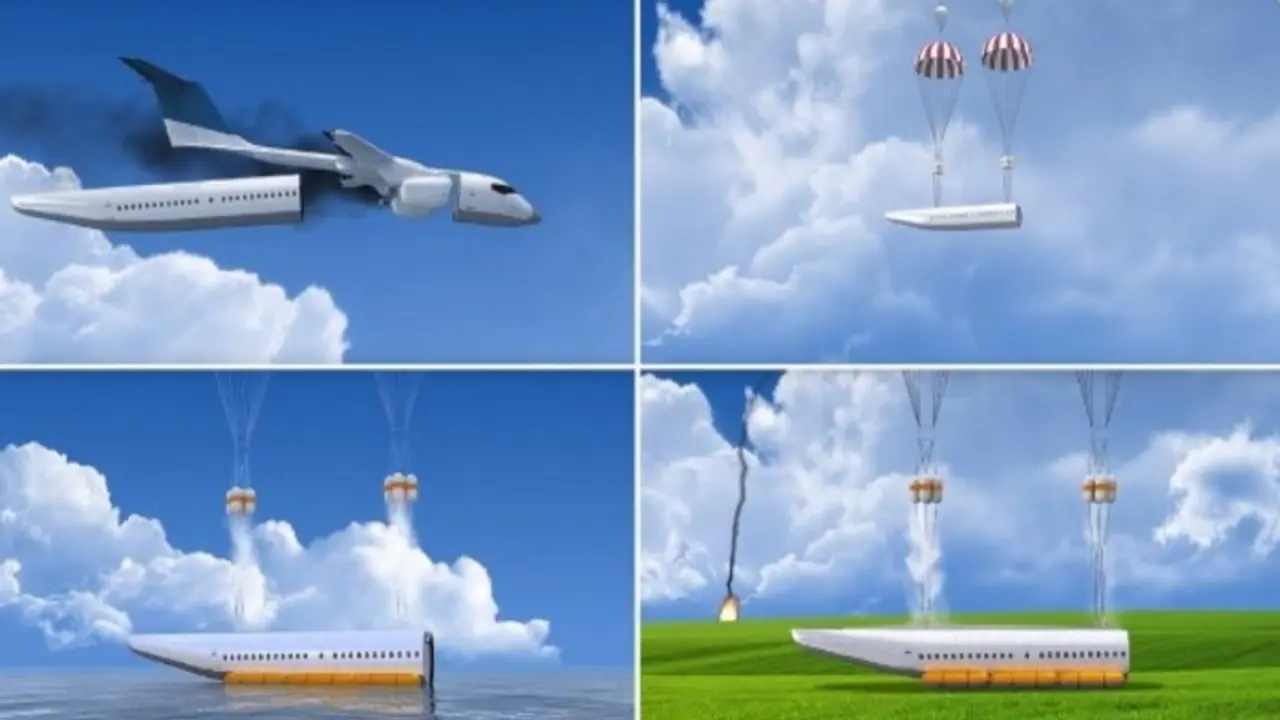After Air India AI171 crashed in Ahmedabad, killing 241 people and leaving just one miraculous survivor, aviation experts are revisiting the concept of detachable cabins, ,n ambitious idea that might offer new hope for survival in mid-air disasters.
The tragic crash of Air India flight AI171 in Ahmedabad, which killed 241 people and left only one miraculous survivor, has reignited a decades-old aviation debate: Can detachable airplane cabins save lives in such disasters?

As investigators search for answers and the nation mourns, experts are revisiting this radical concept that, if implemented, might someday transform how passengers survive plane crashes.
What is a detachable cabin and how does it work?
A detachable cabin is a proposed safety system where the entire passenger section of an aircraft can separate from the main body during an emergency. The cabin would then descend using parachutes, with airbags and life vests providing a softer landing, on land or water.
This system could potentially bypass the delay in rescue operations and help avoid fatalities in mid-air failures or crashes.
The detachable airplane cabin concept, patented by Airbus and proposed in detail by Ukrainian engineer Vladimir Tatarenko, aims to improve safety by allowing the cabin to separate mid-air during emergencies.
Though promising, experts say its cost, technical challenges, and limited effectiveness during takeoff and landing pose significant obstacles to implementation.
When could it actually work and when not?
Despite its futuristic appeal, the detachable cabin concept is only theoretically effective in very specific scenarios:
- The majority of air crashes (around 75%) occur during take-off or landing, when there’s too little altitude for a cabin to detach and deploy parachutes safely. That was exactly the case in the AI171 crash, which happened within seconds of take-off.
- Over populated areas, a detached cabin could pose a danger to people on the ground.
- During loss-of-control incidents, the system may not function at all.
However, in some mid-air emergencies during cruise like structural failure, decompression, or engine explosion, the system might offer a survival advantage. But such events are rare.
The AI171 tragedy: Would a detachable cabin have helped?
Experts say that in the case of AI171, where the aircraft crashed shortly after becoming airborne, a detachable cabin would have been of little or no use. With the plane at low altitude and high vulnerability, there wouldn’t have been enough time or space for a safe detachment or parachute deployment.
Yet, the shock of losing 241 lives, contrasted with one person’s survival, has reignited interest in technologies that might prevent total fatalities, especially during the cruise phase, where some past crashes have left no survivors at all.
Efficiency and operational benefits
Beyond safety, detachable cabins are being considered for logistical reasons too:
- Cabin modules could be swapped quickly, allowing faster aircraft turnaround times.
- Airlines might keep planes flying more often by avoiding long interior repairs.
- Airbus’s patent even includes a plan where passengers board the cabin inside the terminal, which is then attached to the aircraft.
- This could transform not just safety, but airport operations and aircraft maintenance altogether.
Sustainability and environmental implications
There are potential green benefits as well:
- Aircraft bodies could be reused longer, with only cabins replaced or upgraded.
- Modular designs could be customised per flight, improving fuel efficiency.
- Fewer materials may be needed in retrofits, reducing the aviation industry’s environmental footprint.
However, critics point out that the added weight from detachment systems, parachutes, and reinforcements could actually increase fuel consumption, partially offsetting any environmental gains.
The engineering and cost challenges
Turning this into a reality is an enormous challenge:
- The mechanical systems for detachment and safe descent must be extremely reliable.
- The cabin must stay secure during flight but release flawlessly in seconds during emergencies.
- Adding this system means increased aircraft weight, complex maintenance protocols, and costs running into billions.
As one critic noted, “Weight is everything” in aircraft design. Every added kilogram increases fuel burn and reduces payload capacity.
Can detachable cabins really save lives?
While the emotional aftermath of the AI171 tragedy makes any life-saving idea worth exploring, many aviation engineers remain sceptical:
- Most accidents (over 80%) stem from human error or poor weather, cases where detaching the cabin won’t help.
- Even in rare incidents like US Airways Flight 1549, where birds disabled both engines, the pilot’s emergency water landing was the key to survival, not any futuristic system.
- In urban environments like Ahmedabad, a detached cabin might even worsen the toll by crashing into crowded neighbourhoods.
The verdict: Promising, but not yet practical
Though the idea of a detachable cabin has technological promise, it's still in early experimental stages, and not ready for commercial aircraft. The Hermes space shuttle project in Europe once explored a similar concept post-Challenger disaster, but abandoned it due to high cost and complexity.
For now, advanced pilot training, better sensors, AI-assisted controls, and stronger aircraft materials remain the best tools to enhance aviation safety. But as the world reflects on the AI171 catastrophe, the search for breakthrough technologies like this continues with urgency, caution, and hope.


